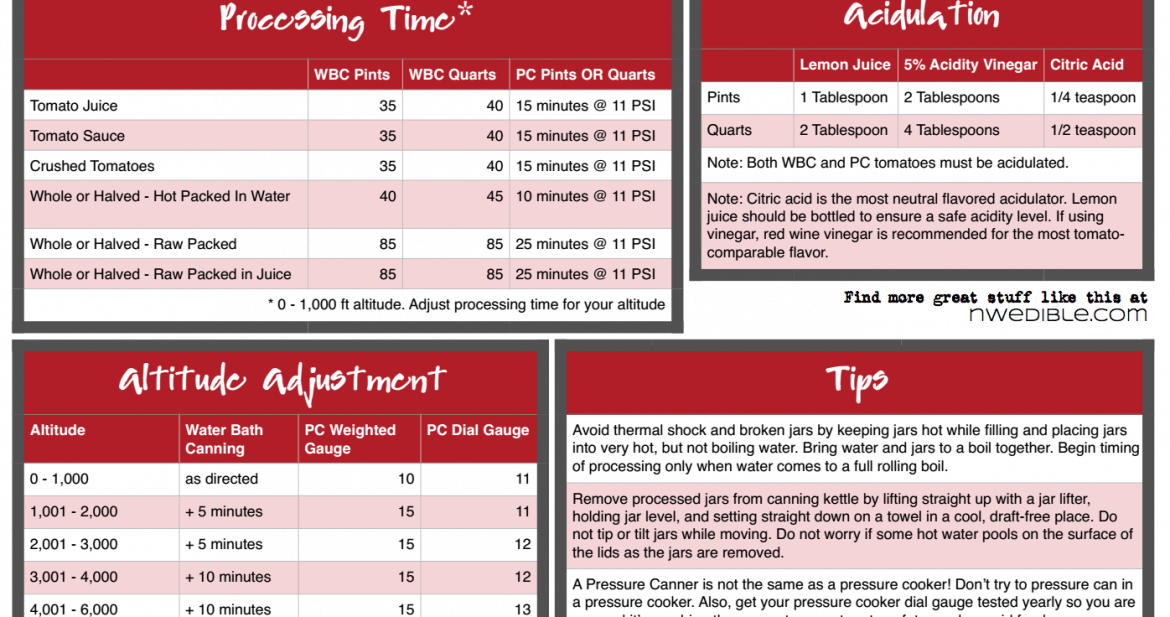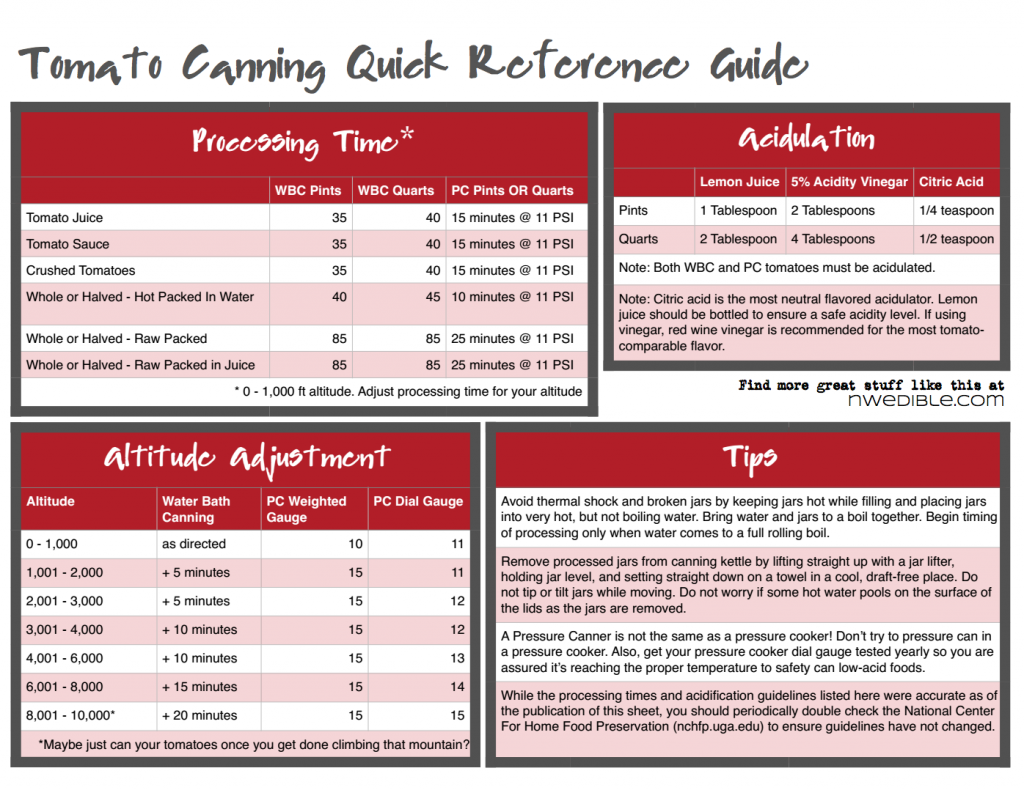When I was canning up tomatoes this past weekend, and I was sick, so I kept double checking things and kinda getting hazy about what the hell I was doing.
Moral of the story: do not attempt to can 100 pounds of tomatoes while sick. But as I was shuffling back and forth to my computer to double and triple check my acidulation and processing times at the National Center For Home Food Preservation, I kept thinking, “I wish I had all this information on one piece of paper that I could print out and not worry if it got totally covered in tomato schmeck.
So I made this. Hope you guys find it helpful, too.
Update! The original version of this chart had the citric acid needed for pints and quarts reversed – sorry guys! The current version is accurate, so please re-download or make a note on your chart.
You can download a free, printable PDF of the Tomato Canning Quick Reference Guide here.
How do you typically preserve your tomato harvest?
28

I never understood why they still say to ad avoid when pressure canning tomatoes. … you don’t add acid to beans when pressure canning them. Ive found the added acid throws the flavor off so one resorted to freezing.
Yeah, I know. I’ve researched the heck out of this, trying to find an “official” way around it. It’s because tomatoes are only briefly pressure canned, so the powers that be aren’t guaranteeing that the 240* is processing long enough to kill the spores that can lead to botulism toxin. So there’s still a reliance on pH to prevent c. botulinum spore germination. Although my feeling is that, if it’s safe to pressure can unacidulated tomatoes combined with super low-acid zucchini, as in this approved recipe, it would have to be safe to process just tomatoes at the same time and pressure combo. But then you are looking at 35 minutes of processing time instead of probably 15.
At the risk of sounding like a total fool I wonder if citric acid is necessary at all I have water bath canned tomatoes for two year as now and o have never used it. Maybe the tomatoes I get are extra acidic? Or am I just lucky to still be alive? I do make more of a cooked sauce than just packing raw tomatoes so maybe that’s the trick?
Short answer: You’re lucky to be alive. Tomato acidity is reduced as they ripen (and over-ripen). They go from being a high-acid food to a low-acid food. Since you can’t really know what stage they’re at without high-tech equipment, an acid is added when canning. Anything else you add (peppers, onions, seasonings) lowers the acidity, too.
Ignore past successes with canning using untested recipes and procedures. Stick with tested, safe methods you can find through extension services or dependable sources like Ball.
Ughhj auto correct… *add acid* *so I’ve*
LOL! Download and LAMINATE! Thanks for the quick reference. Hope you’re feeling better.
I made a cheat sheet like this a few years ago–times, headspace, and pounds of ingredients for basic amounts (ie 2 pounds of toms yields ~ 1 pint sauce, etc). On the other side of a sheet protector I have one for freezing too (with blanching times etc). It’s funny though how my stand-by preserving has changed over the years, I really need to update it.
Great resource! One thing, the citric acid amounts are reversed for pints and quarts in the upper right box. (I’ve been canning tons of tomato juice lately, so I’ve been going over times and amounts just like you.)
Awesome! Fixing Now…
Yes, love this!! Totally beats the 5 pages I printed off their website last summer and kept having to flip back and forth.
Last year was only my second of canning anything. The first year I just did whole tomatoes, but last year I did whole, crushed, and sauced (using your tips for using all the leftover skins and such for the sauce, it was great!). I wrote up a post about the pros and cons of each for me: http://myhomespunhome.wordpress.com/2013/09/26/to-may-to-ta-mah-to/
What’s amazing to me is that I actually still have tomatoes left from last summer! I didn’t think I’d have any trouble getting through them. Oh well, a good excuse for pizza in the grill so I can free up jars for this year’s tomatoes 🙂
sorry but what is WBC?
duh just got it ! oh vey! lol
Under Tips you might want to change “…get your pressure cooker dial gauge tested…” to pressure canner. 😎
Bwaaaaa hah hah! Fixed. Going back to bed now. 😉
Very usefull, thanks!!
I have historically done pints of stewed tomatoes, which have been fantastic. However, after last year, in which I felt I spent an entire evening to make a mere six pints of stewed tomatoes, I’ve tried raw packing whole tomatoes this year. While I my time-output ratio has dramatically improved, I am having a lot of issues with siphoning with the raw pack. I’ve left plenty of head space, the packing water has been boiling….I’m not sure why I am getting siphoning. (The first batch, my (crappy) glass top stove had an F10 error and died just before I got to processing. I stored them overnight in the fridge, slowly brought them up to temperature before processing on a friend’s stove and had serious issues with siphoning…I *get* why there.) The second batch was done perfectly, as far as I can tell, start to finish. The siphoning wasn’t nearly as bad, but still more than I expected, but I haven’t done a whole lot of raw pack?
By “stewed” I mean “crushed.”
I’ve had siphoning problems in the past and one thing that can be a factor is putting forth more heat than your pot needs to keep things at a boil. Once whatever I am canning comes to a full boil (starting the processing time) I give it 5 minutes and then turn the heat down a bit on my stove. I’m still maintaining a good full boil the entire time. But I’ve found leaving the setting fully on high not only wastes fuel but has created siphoning problems for me in the past. Just remember, if you turn it down to much and your pot stops boiling you have to bring it back up to a boil and start the processing time all over again. Hope this helps!
Thanks, Kay! I will definitely play with that!
I sometimes have siphoning at the end of processing–I think turning off the heat at the end of the time and letting them stand for 5 minutes helps with this. That said I have pretty much given up on canning whole tomatoes–I find the end product is so similar– and crushed are so much easier!
Consider tightening the bands a wee bit more before processing. I’ve noticed a big reduction in siphoning by doing that.
I chop, cook down and freeze most of my tomatoes. It’s quick and easy and no big clean up! I also freeze raw chopped tomatoes when I’m short on time.
When I’m short on time I just freeze them whole (small and medium size). When they thaw they go first in the blender to chew up the skins, and then into the cooking pot. Wonderful!
I like to roast my tomatoes with olive oil and herbs. Then I’d like to can them safely. Formerly I’ve been freezing them. What do you advise for canning?
Very helpful – I too get foggy and then worried about whether I got the acid levels correct with WBC!
Thanks very much!
I have a book with a 1995 copy write that says to process raw pack tomatoes for 45 minutes. In Ball’s Blue Book from 1969 it also calls for 45 minutes (this time with no added acid). I understand that tomatoes today are possibly lower in acid, but why the increase in processing time? More importantly, does the increased processing time dilute the taste of the tomatoes?
The culture of fear that has invaded this country never ceases to amaze. First, I have quite few credits in microbiology so I don’t to something stupid. Second, I’ve been canning for nearly 50 years – doubt I’ll change now – for straight tomatoes I don’t add anything. I do use longer times for salsa. Third, I only preserve canning type tomatoes, such as Heniz Processor (also incredible yields). Finally, I have always used a plug in roaster oven on about 300° F to keep the jars hot. I returned the filled jars to oven until I have a canning pot full, then put them in the boiling water all at the same time. It is much easier and tones down much of rising steam. When it is 90° F and 85% humidity every little bit counts.
I make a slit through skin of tomatoes, drop them in boiling water for a minute or 2 depending on how big they are then drop them in cold water, peel off the skin and then freeze. So much easier and I think the flavor is better. Thaw them and throw in the crockpot to make whatever sauce, spaghetti or sauce for chili when ready. Also take these tomatoes when fresh and make sauce and then freeze it.
Great timing as I’m gathering our tomatoes for a big saucing weekend. One thing you might find interesting is this article I found last year regarding lemon juice. I’d always prefer to you the real “real lemon” juice: http://agardenerstable.com/2011/04/19/real-lemon-versus-realemon/
Canning would heat up my tiny home to an unbearable temp, so I freeze whole tomatoes. When frozen, I run them under a bit of warm water to remove the skins then chop and package in freezer zip locks – all while still frozen. Chopping icy cold tomatoes on a 90° day is a delight! The frozen chunks are easy to measure out for recipes.
I’m in the midst of putting up a bunch of tomatoes and printed this off to use, but found 1 thing missing: headspace. Do you think you could add that? I’m not experienced enough to know what it should be off-hand. I looked it up just now, but it would be super helpful to have on the cheat-sheet!
Hi, just a heads up that I checked the NCHFP guidelines for canning crushed tomatoes and they have quarts for water bath canning at 45 minutes, not 40 as stated in the above NWE guide. Happy canning!
Thanks Starla,
I wonder if the processing time changed? I will try to update the chart as soon as I can.